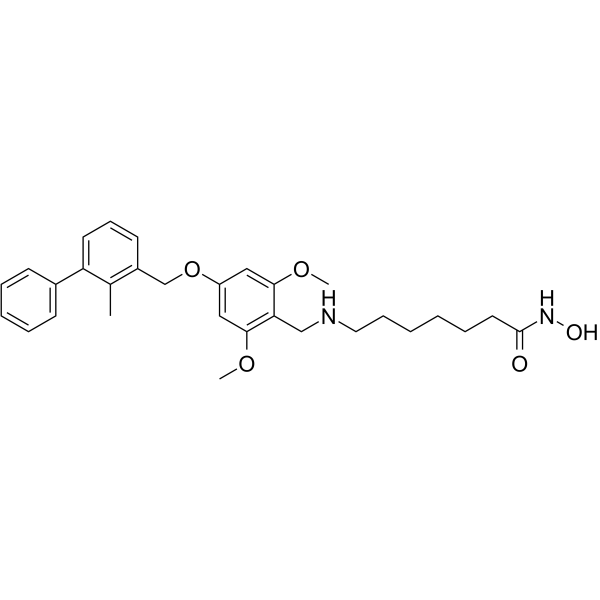HDAC6-IN-4
Modify Date: 2025-08-27 10:10:58

HDAC6-IN-4 structure
|
Common Name | HDAC6-IN-4 | ||
|---|---|---|---|---|
| CAS Number | 2709103-20-6 | Molecular Weight | 506.63 | |
| Density | N/A | Boiling Point | N/A | |
| Molecular Formula | C30H38N2O5 | Melting Point | N/A | |
| MSDS | N/A | Flash Point | N/A | |
Use of HDAC6-IN-4HDAC6-IN-4 (C10) is a potent, orally active and highly selective HDAC6 inhibitor with an IC50 value of 23 nM. HDAC6-IN-4 induces cancer cells apoptosis and shows significant antitumor efficacy, without obvious toxicity[1]. |
| Name | HDAC6-IN-4 |
|---|
| Description | HDAC6-IN-4 (C10) is a potent, orally active and highly selective HDAC6 inhibitor with an IC50 value of 23 nM. HDAC6-IN-4 induces cancer cells apoptosis and shows significant antitumor efficacy, without obvious toxicity[1]. |
|---|---|
| Related Catalog | |
| Target |
HDAC6:23 nM (IC50) HDAC3:46 nM (IC50) HDAC2:172 nM (IC50) HDAC8:2175 nM (IC50) HDAC1:3604 nM (IC50) |
| In Vitro | HDAC6-IN-4 (C10) (0-50 µM, 72 h) shows strong antiproliferative activity against different cancer cells with low cytotoxicity[1]. HDAC6-IN-4 (0-6 µM, 24 h) exhibits significant selectivity for HDAC6 over HDAC1[1]. HDAC6-IN-4 inhibits migration activity in a time-dependent and dose-dependent way in B16 and CT26 cells[1]. HDAC6-IN-4 (0-8 µM, 24 h) induces B16 cell apoptosis in a dose-dependent manner[1]. HDAC6-IN-4 exhibits significant plasma stability in humans (97% retention after 6 h), and exhibits significant metabolic stability in human (half-life of 101.91 min) and mouse liver (half-life of 67.94 min) microsomes[1]. Cell Proliferation Assay[1] Cell Line: B16, HepG2, A549, and CT26 cells Concentration: 0-50 µM Incubation Time: 72 h Result: Showed antiproliferative activity with IC50 values of 1.52, 2.36, 5.77, and 2.09 µM against B16, HepG2, A549, and CT26 cells, respectively. Western Blot Analysis[1] Cell Line: B16 and CT26 cancer cells Concentration: 2, 4, and 6 µM Incubation Time: 2, 4, 8, 12, and 24 h Result: Dramatically increased the level of Ac-Tub (acetyl-α-tubulin) in a dose-dependent and time-dependent manner. Had almost no effect on the content of Ac-H3 (acetyl-H3). Apoptosis Analysis[1] Cell Line: B16 cells Concentration: 4, 6, and 8 µM Incubation Time: 24 h Result: Caused moderate to potent induction of apoptosis in the B16 cell line in a dose-dependent manner. Upregulated the expression of apoptotic protein cleaved PARP. |
| In Vivo | HDAC6-IN-4 (C10) (0-100 mg/kg; i.g.; once daily for 21 days) shows excellent antitumor activity and significantly promoted T cell response in a dose-dependent manner, with no obvious toxicity[1]. Animal Model: Five-week-old C57BL/6 mice (immune-related CT26 xenograft model)[1]. Dosage: 50 and 100 mg/kg Administration: Oral gavage, once daily for 21 days Result: Resulted in a substantial tumor growth and tumor tissue size inhibition in a dose-dependent way. Showed significantly high antitumor activity (TGI = 75%) at 100 mg/kg. Raised the plasma IFN-g level and the numbers of CD+ and CD3+CD+ (activated cytotoxic T) cells. Decreased CD4+CD25+CD127low/- T regulatory cells. Showed no obvious toxicity. |
| References |
| Molecular Formula | C30H38N2O5 |
|---|---|
| Molecular Weight | 506.63 |
| InChIKey | NWHRMDIXMQBLHY-UHFFFAOYSA-N |
| SMILES | COc1cc(OCc2cccc(-c3ccccc3)c2C)cc(OC)c1CNCCCCCCC(=O)NO |